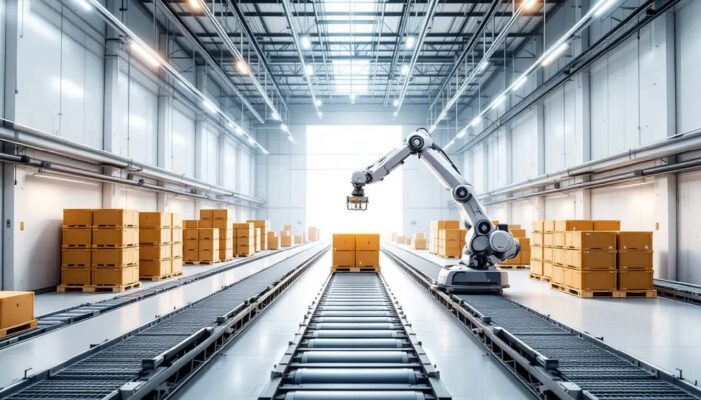Uncategorized
Top Warehouse Conveyor Solutions
Top Warehouse Conveyor Solutions: Streamlining Material Handling Processes
 Want to boost your warehouse efficiency? Warehouse conveyor solutions streamlining material handling processes can automate workflow, reduce errors, and save costs. This article delves into the types of conveyor systems, their components, and how they benefit operations.
Want to boost your warehouse efficiency? Warehouse conveyor solutions streamlining material handling processes can automate workflow, reduce errors, and save costs. This article delves into the types of conveyor systems, their components, and how they benefit operations.
Key Takeaways
- Efficient material handling is crucial for warehouse operations, significantly impacting productivity, customer satisfaction, and operational costs.
- Understanding the key components and types of conveyor systems allows warehouses to optimize their material handling processes and choose the right solution for their specific needs.
- Maintenance and safety measures for conveyor systems, including regular inspections and employee training, are essential for ensuring optimal performance and reducing workplace injuries.
The Importance of Efficient Material Handling in Warehouses
The paramount importance of efficiency in warehouse operations cannot be overstated, as it conserves vital time and resources while markedly enhancing customer satisfaction. In the swiftly moving domain of logistics and supply chain management, moments are precious, with the rapid and precise movement of materials potentially distinguishing one company from its rivals. The implementation of conveyor systems is crucial to this end. By mechanizing the transport of goods, they cut down on manual effort and diminish errors attributable to human involvement.
Beyond mere transportation tasks, conveyor systems contribute to a meticulously arranged process aimed at augmenting productivity while trimming costs across various industries. Through these automated pathways for material flow within warehouses comes improved workflow optimization—key benefits include adept handling abilities alongside reduced threats relating to theft or degradation—and thus bolstering client fulfillment through quicker delivery times coupled with pristine product conditions.
Such advancements directly affect essential operational metrics like transit durations, maximization of resource deployment along with elevated service quality standards. By embracing conveyors within their logistic processes—a move that fosters fluidity across both incoming and outgoing activities—the demands placed upon contemporary warehousing facilities can be met proficiently.
Ultimately keeping pace with ever-evolving industry standards means holding steadfast in process efficacy—an undeniable requisite for those vying for success amidst fierce competition within the realm of logistics management.
Key Components of Warehouse Conveyor Systems
Grasping the essential elements of conveyor systems is essential for recognizing their advantages. The core component is the belt, which carries items from one location to another and constitutes the principal part responsible for motion. These belts are driven by electric motors that facilitate a steady flow of material movement.
For maintaining efficiency and safety during operation, control systems play an imperative role in regulating both the velocity and directionality of belts per predefined rules and regulations. Rollers serve as crucial support structures that stabilize and guide these belts, thereby enhancing overall conveyor system effectiveness.
In unison, these parts form an integrated system designed to streamline material transportation within warehouse environments.
Types of Conveyor Systems
Various types of conveyor systems are available to meet the diverse needs of operations. One widespread variant is the belt conveyor, which utilizes continuous rotating belts for product transportation and is constructed from layers of durable rubber or similar materials with a densely woven fabric core. This design renders them appropriate for transporting an expansive array of goods, making them suitable for various business operations.
In scenarios where lighter items need moving in a cost-effective manner, gravity roller conveyors prove advantageous. These systems harness gravitational force to propel products along their path, thus serving as an efficient option in environments where conserving electrical energy is prioritized.
Flexible conveyors stand out due to their adaptability. They can be easily customized and reconfigured to accommodate different spatial arrangements and shifting operational demands.
Identifying the specific material handling requirements and limitations unique to your industry is crucial when selecting a conveyor system that will effectively elevate your warehouse’s productivity levels. Each kind brings its distinct benefits that contribute substantially towards streamlining processes across various sectors.
Choosing the Right Conveyor System
It is crucial to meticulously assess your warehouse’s unique needs before choosing the right conveyor system. This includes examining various elements such as the nature of products handled, intended operational targets, and established workflow tendencies. A belt conveyor system could be more advantageous for warehouses that manage delicate goods, whereas gravity roller conveyors may be a better match for those transporting heavier items.
Projecting future expansion should also factor into decision-making when selecting a conveyor system. Opting for a system with expandability in mind can prevent costly expenditures and wasted time down the line. The correct choice of conveyor not only streamlines operations, but also optimizes use of space and enhances overall productivity.
Enhancing Efficiency with Conveyor Systems
The process of material handling is crucial for enhancing warehouse productivity, ensuring safety and boosting employee morale. Utilizing conveyor systems allows warehouses to expedite item processing, resulting in a notable uptick in productivity. Such systems facilitate the seamless transit of goods, which minimizes manual labor stress on employees, fostering a safer work environment and enhancing satisfaction for customers.
Technological progress has paved the way for AI-powered autonomous conveyor systems that are poised to transform warehouse functions radically. These advanced setups can refine routing and elevate performance by evaluating data from ongoing operations, thus bolstering efficiency.
We shall delve into how conveyor systems accelerate the movement of materials while simultaneously curtailing operational expenditures.

Speeding Up Material Movement
The utilization of conveyor systems facilitates uninterrupted operation, which in turn expedites the handling of materials and enhances their movement. By enabling goods to be swiftly transferred from one location to another, these systems diminish wait times and improve service efficiency. Rollers coupled with low-horsepower motors are employed within these systems to ensure a seamless transfer of products, optimizing the process’s efficacy and ensuring they comply with operational guidelines.
By speeding the conveyance of materials, warehouses are better equipped to fulfill stringent timelines, manage substantial quantities of items, and augment both productivity levels and consumer satisfaction.
Reducing Operational Costs
Conveyor systems offer a major benefit in lowering operational expenses by automating the transport of goods, which diminishes the need for manual labor and consequently lowers workforce costs. These systems make excellent use of space within warehouses, enabling more items to be stored in less area.
Through reducing reliance on manual tasks, maximizing resource usage and minimizing mistakes, conveyor systems notably cut down on operational expenditures. Continuous upkeep guarantees their efficient performance, thereby amplifying the cost-saving advantages.
Integrating Conveyor Systems into Existing Infrastructure
A holistic approach is vital for successfully incorporating conveyor systems into an established warehouse setting. This encompasses meticulous planning, precise installation, and thorough training to guarantee a smooth shift and peak efficiency, in accordance with government policies. Ensuring the successful integration of new conveyor systems hinges on crafting a detailed plan that addresses both installation requirements and electrical considerations.
Incorporating smart technologies within warehouse operations by implementing advanced conveyor systems promises optimized functionality through interconnected data sources. The use of modular conveyors, which can be readily adapted for scalability purposes, empowers warehouses to efficiently accommodate fluctuating demands.
Subsequent sections will delve into evaluating the specific needs of warehouses as well as detailing the steps involved in executing and testing conveyor system installations to ensure they meet operational standards.

Assessing Warehouse Needs
Evaluating the requirements of a warehouse is an essential process in choosing an appropriate conveyor system. This evaluation includes examining the space on hand, various product types that will be conveyed, patterns of workflow, projections for future expansion, and maximum operational capacity during peak times. A firm grasp on these elements aids in selecting a conveyor system that integrates seamlessly with existing operations and complies with federal regulations.
To maintain efficiency within warehouse operations, it’s crucial to regularly monitor and refine material handling procedures. A comprehensive analysis of these needs guarantees that selected conveyor systems are capable not only of meeting present demands but also of adapting to future ones.
Implementation and Testing
The process of setting up a conveyor system includes rigorous testing and meticulous quality checks to guarantee proper operation. Such assessments serve to uncover and rectify any problems before the system becomes operational, facilitating seamless procedures. It is essential to conduct training sessions for warehouse workers as part of the integration process to ensure safety and efficiency in their roles.
These instructional programs must encompass correct usage practices, emergency response measures, and the identification of potential hazards relevant to those who manage conveyor systems. Consistent safety instruction diminishes accident risk significantly and bolsters general safety within the warehousing environment.
Maintenance and Safety Measures for Conveyor Systems
Ensuring the proper functioning and extended lifespan of conveyor systems requires consistent maintenance. The seamless and secure running of these mechanisms hinges on their successful incorporation into current structures, with regular upkeep and attention to safety being vital components. Utilizing IoT sensors for predictive maintenance can preemptively detect problems before they result in operational interruptions, thus improving efficiency and ensuring compliance with the law.
Moving forward, our emphasis will be placed on routine preservation measures as well as maintaining the protection of workers during the operation of conveyors.
Regular Maintenance Practices
Regular examinations and cleaning of conveyor systems stave off deterioration and expensive malfunctions. It’s crucial to assess the state of belts, rollers, and motors during these inspections in order to detect problems before they escalate. Proper lubrication of parts is also essential as it diminishes friction and wear, thereby improving the efficiency of the system.
Adhering to such upkeep protocols prolongs the service life of conveyor systems while averting significant repairs that may be costly.
Ensuring Employee Safety
Conveyor systems improve safety by reducing the physical strain on workers, which can lead to fewer workplace injuries. Adjustable workstations, anti-fatigue mats, and wrist supports can enhance ergonomics for employees interacting with conveyor systems. Advanced technologies like proximity sensors and automated warning systems further enhance the safety of these systems.
Regular safety training, safety guards, emergency stop buttons, clear instructions, and inspections are crucial for employee protection during conveyor operations, in accordance with regulations set by the authority.
Real-World Examples of Streamlined Warehouses
Illustrative instances highlight the effectiveness of conveyor systems in bolstering productivity and efficiency within warehouses. For instance, a prominent retailer adopted an automated conveyor system, which slashed their processing duration by 30%, thereby markedly boosting overall throughput.
In another scenario, a food distribution hub modernized its conveyor infrastructure and saw order fulfillment times diminish by 25%. Similarly, when a pharmaceutical storage facility incorporated such a system, they experienced manual handling mistakes fall by 40%.
Likewise, after incorporating conveyors into their operations, one manufacturing entity managed to double production without extending operational hours. Concurrently, an electronics depot refined its conveyor setup to better manage demand spikes — this led to higher levels of customer satisfaction.
As these scenarios indicate, employing conveyor systems has been consistent in escalating efficiency while curbing labor expenses and heightening precision during warehouse processes, in compliance with agency regulations.

Future Trends in Warehouse Conveyor Technology
Technologies such as artificial intelligence and machine learning are set to improve operational efficiency and foresee maintenance requirements in the domain of warehouse conveyor systems. These cutting-edge innovations are fostering the creation of faster, more capable systems adept at processing an increased quantity of goods.
By employing Warehouse Management Systems with real-time tracking capabilities, decision-making and inventory control will be significantly improved during peak times. The application of IoT sensors is also pivotal for predictive maintenance, which can preemptively identify potential issues, thereby minimizing disruption.
To maintain pace with evolving demands without necessitating extensive alterations to infrastructure, modular conveyor solutions have been introduced. The emphasis on crafting energy-efficient conveyors stands as a testament to commitment towards sustainability within logistics operations. Lastly, autonomous conveyors are being developed that reduce reliance on manual labor thus augmenting time-efficiency across the board.
Summary
To summarize, conveyor systems are essential for optimizing warehouse functions as they not only elevate productivity and slash running expenses, but also bolster safety measures and heighten consumer contentment. Recognizing the crucial elements, diverse categories, and optimal methods of amalgamation enables warehouses to maximize the capabilities offered by these mechanisms.
Looking ahead, the assimilation of sophisticated technologies such as Artificial Intelligence (AI) and the Internet of Things (IoT) is set to transform conveyor systems into more effective and sustainable assets. By adopting these technological advancements, businesses can maintain their edge in competitiveness while addressing the continuously escalating requirements within logistics sectors.

Frequently Asked Questions
What is an example of signage?
An example of signage includes digital displays such as LCD screens and LED billboards, which effectively convey information in various environments.
These modern options enhance visibility and engagement for audiences.
What is an example of regulation?
Regulations, such as those for environmental protection that set pollution limits and uphold safety standards, serve as a prime example of how regulatory measures are implemented to ensure the wellbeing of public health and the preservation of our environment.
What are the key benefits of using conveyor systems in warehouses?
Employing conveyor systems within warehouse environments markedly enhances productivity and diminishes operational expenses by automating the movement of materials. This advancement not only elevates safety, but also increases customer satisfaction via refined workflow processes.
How do I choose the right conveyor system for my warehouse?
To choose the right conveyor system for your warehouse, assess your specific needs, including product types, operational goals, available space, workflow patterns, and any future growth projections.
This careful evaluation will ensure you select a system that effectively supports your operations.
What maintenance practices are essential for conveyor systems?
Regular inspections, cleaning, lubrication of components, and early issue identification are essential maintenance practices for conveyor systems to prevent wear and costly breakdowns.
Prioritizing these practices ensures optimal performance and longevity of the system.
For more information, contact us here.

